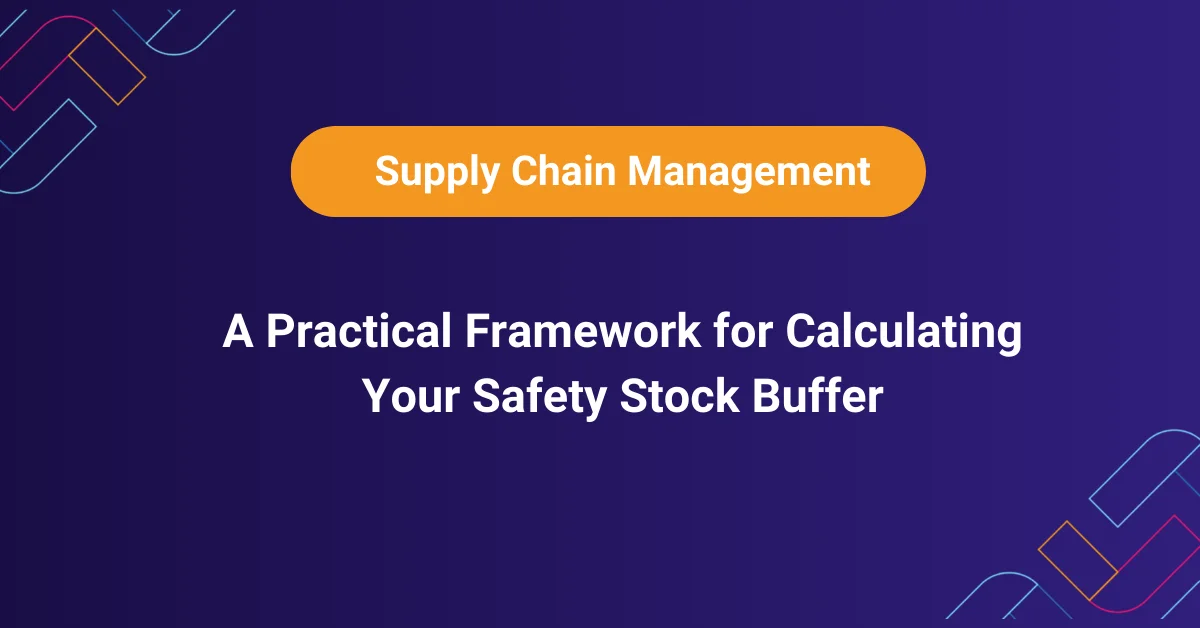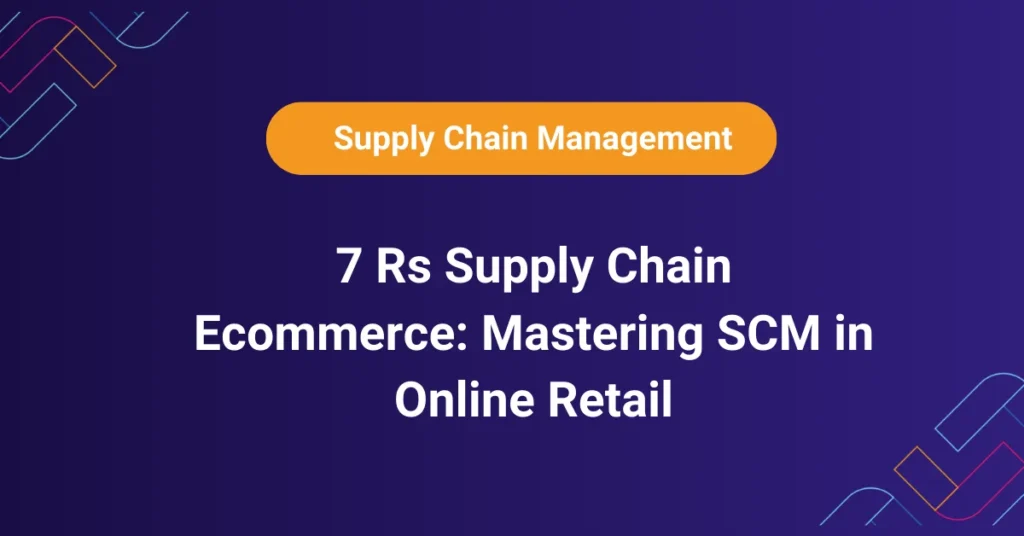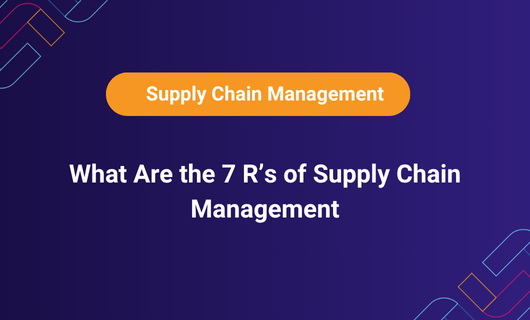That sinking feeling is all too familiar. Your warehouse management system flashes an alert for a top-selling product. You’re down to the last few units, and your next shipment is weeks away. The result? The dreaded “Out of Stock” message, a plummeting Amazon ranking, and a week’s worth of ad spend down the drain. If your team is constantly reacting to shortages instead of planning for demand, it’s time for a new approach. What would it take to transform your inventory from a constant worry into your most reliable asset? For operations leaders at scaling brands, hope isn’t a strategy. The answer lies in a calculated, mathematical approach, starting with mastering the right safety stock formulas for E-commerce.
This guide strips away the theory and delivers the exact methodology used by enterprise operations teams to build a bulletproof inventory plan
A Practical Framework for Calculating Your Safety Stock Buffer
Forget generic advice and theoretical concepts that don’t apply to the chaos of real-world e-commerce. What follows is a tactical playbook for founders and ops veterans who are done with guesswork and ready to implement a data-driven defense against stockouts. We’ll deconstruct the entire process, from gathering the right data to selecting the correct safety stock formula for your specific challenges — whether you’re battling volatile demand, unpredictable shipping lanes, or the complex logistics of marketplace selling. For brands seeking external expertise, partnering with experienced supply chain consulting firms can accelerate implementation and ensure your strategies are tailored to both operational realities and growth goals.

The Real Business Impact of an Empty Shelf
For a brand doing eight figures or more, a stockout isn’t a minor inconvenience—it’s a cascade of operational and financial failures.
Direct Revenue Leakage: The most obvious hit. You lose the margin from every single missed order.
Algorithmic Penalties: Amazon’s A9 algorithm is ruthless. An out-of-stock listing can see its Best Seller Rank tank, killing organic visibility for weeks. The cost to claw your way back with ads is staggering.
Erosion of Trust: A segment of your customers won’t come back. You’ve not only lost a sale but also a portion of their lifetime value.
Operational Drag: Your team wastes precious hours managing backorders, dealing with customer service fires, and paying exorbitant fees for rushed freight. This is a distraction from growth-focused work.
The Four Pillars of Your Calculation
Before you can calculate anything, you need rock-solid data. Isolate these four metrics for every single SKU in your portfolio.
Average Daily Demand (μ_d): The straightforward average of units sold per day. Calculate this over a meaningful period, like a full quarter, to smooth out blips.
Standard Deviation of Demand (σ_d): This is the heartbeat of your forecasting. It doesn’t measure how much you sell, but how unpredictable your daily sales are. A high number here means your product is subject to viral trends, competitor actions, or other volatility.
Average Lead Time (μ_LT): The total number of days from the moment you click “place order” with your supplier to the moment that stock is on the shelf at your 3PL and available for sale.
Standard Deviation of Lead Time (σ_LT): The report card on your supplier’s reliability. A perfect score is zero, meaning they never deviate from their promised timeline. Most brands, however, see a number that reflects the messy reality of global logistics.
How often should I recalc safety stock?
For stable products, a quarterly review is a minimum. For anything fast-moving or seasonal, make it monthly. Consider any major event—a new supplier, a 100% growth month, a key PR hit—an automatic trigger for a full recalculation. Doing this manually is a pain, which is why leaders automate it.
The Formulas: Matching the Tool to the Task
Not all inventory challenges are created equal. Using a simple calculation for a complex scenario is a guaranteed path to failure. The right safety stock formulas should align with your inventory forecasting and demand planning process, ensuring they reflect the realities of your business.
Use this only if your supplier’s lead time is exceptionally consistent (low variance).
Safety Stock = Z-score * σ_d * √(Average Lead Time)
Z-score: This is your service level target.
90% Service Level → Z = 1.28
95% Service Level → Z = 1.65 (Common for core products)
99% Service Level → Z = 2.33 (Costly buffer)
Example: You sell 15 units/day on average (μ_d) with high volatility (σ_d = 4). Your lead time is a reliable 10 days. For a 95% service level:
Safety Stock = 1.65 * 4 * √(10)Safety Stock = 1.65 * 4 * 3.16Safety Stock ≈ 21 units
What is the difference between ROP and EOQ?
ROP (Reorder Point) tells you when to order (the inventory trigger). EOQ (Economic Order Quantity) tells you how much to order to minimize costs. They work together.
The Enterprise Formula (For Real-World E-Commerce)
This is the essential safety stock formula for most brands, as it buffers against both unpredictable demand and unreliable suppliers.
Safety Stock = Z-score * √[ (μ_LT * σ_d²) + (μ_d² * σ_LT²) ]
Example: Same product (μ_d=15, σ_d=4). Lead time averages 10 days but is unreliable (σ_LT = 3 days). For a 95% service level:
Inside the square root:
(10 * 4²) + (15² * 3²) = 160 + 2,025 = 2,185√2,185 ≈ 46.74Safety Stock = 1.65 * 46.74 ≈ 78 units
The Critical Takeaway
Notice the staggering difference? Ignoring lead time variability suggested a 21-unit buffer. Acknowledging the real-world unreliability of shipping revealed a true requirement of 78 units. This math exposes why so many brands that think they’re covered still face frequent stockouts.
What if lead times are inconsistent?
You must use the full formula that incorporates lead time standard deviation (σ_LT). Burying your head in the sand and pretending your supplier is always on time is the number one reason sophisticated brands still face shortages.
From Buffer to Action: The Reorder Point
Safety stock is your rainy-day fund. The Reorder Point (ROP) is the specific moment you decide to tap into it, triggering a new purchase order to replenish your supplies.
Reorder Point (ROP) = (Average Daily Demand * Average Lead Time) + Safety Stock
Using our complex example:
Average Daily Demand = 15 units
Average Lead Time = 10 days
Safety Stock = 78 units
ROP = (15 * 10) + 78ROP = 150 + 78ROP = 228 units
The instant your sellable inventory dips to 228 units, your procurement process must begin.
Setting Service Levels: The CEO’s Choice
Aiming for a 100% service level is a fantastic way to go bankrupt through overstock. This isn’t just an ops decision; it’s a strategic financial one.
‘A’ Items: Your crown jewels. Target 95-97%. The cost of being out is far greater than the cost of holding extra inventory.
‘B’ Items: The supporting cast. A 90-95% target balances risk and cost effectively.
‘C’ Items: The long tail. An 85-90% service level is often adequate. The capital required to protect every single slow-moving SKU is better deployed elsewhere.
What service level should I target?
It requires a cold, hard financial analysis. You must quantify the true cost of a stockout (lost margin, lost LTV, wasted ad spend) and weigh it against your cost of carry (storage, insurance, capital cost). There is a point of diminishing returns. For most, the sweet spot lies between 92% and 97% for core products.
Navigating Complex E-Commerce Scenarios
The foundational safety stock formula is your baseline, but high-growth brands face unique situations that demand tailored adjustments. Standard calculations fail when you’re launching products, running flash sales, or dealing with multi-tiered supply chains. Here’s how to adapt your strategy for the real-world complexities of scaling an online brand.
Planning for Promotional Spikes and Flash Sales
A planned sale must not cause a stockout. Move from a reactive to a proactive inventory model.
The Problem: Using your historical average demand (μ_d) for a planned 300% demand spike will obliterate your safety stock.
The Solution: Manually override your formula inputs with promotional forecasts.
Replace
μ_d: Use your forecasted daily sales rate (e.g., 300 units/5 days = 60 units/day).Adjust
σ_d: Use volatility data from past promotions or estimate higher volatility.Recalculate: Run the safety stock formula with these temporary inputs to create a dedicated promotion buffer.
Key: Your forecast is only as good as your marketing team’s projections. Tight coordination is essential to avoid failure.
How do promotions change safety stock?
They require a separate calculation using forecasted promotional demand and volatility, not historical data. Ignoring this is a primary cause of promotional stockouts.
The Supplier Buffer vs. 3PL Buffer Decision
Where you choose to hold your safety stock is a strategic decision that impacts lead times, costs, and control.
Buffering at the Supplier (VMI – Vendor Managed Inventory):
How it works: Your supplier holds your safety stock buffer and replenishes your 3PL in smaller, more frequent shipments.
Benefit: Effectively shortens your lead time. Your
μ_LTbecomes the shipping time from the supplier’s warehouse to your 3PL (e.g., 2 days), not the full manufacturing and shipping time from overseas (e.g., 45 days). This allows for a much smaller safety stock buffer.Drawback: You have less visibility and immediate control over the inventory. It also requires a sophisticated, trustworthy supplier partnership.
Buffering at the 3PL:
How it works: You hold all safety stock inventory at your fulfillment center.
Benefit: Maximum control and fastest reaction time to demand spikes. You have real-time visibility into your total available inventory.
Drawback: Requires a larger upfront investment in inventory (as calculated by the full formula with the long lead time) and incurs higher holding costs at the 3PL.
The Calculation: The safety stock formula itself doesn’t change. What changes is the
μ_LTandσ_LTyou input. For supplier buffering, you’d use the short, domestic transit time. For 3PL buffering, you use the long, international lead time.
Managing Kits, Bundles, and Configurable Products
A kit is a single SKU to your customer, but a complex web of dependencies to your inventory manager. Its availability is a function of its least available component.
The Problem: Calculating safety stock for the finished kit SKU is useless. If Component A has a 90% chance of being in stock and Component B has a 90% chance, the probability that both are in stock to build the kit is only 81% (0.9 * 0.9).
The Solution: You must calculate safety stock for each component SKU individually at a higher service level to ensure the finished product’s availability.
Determine your desired service level for the finished kit (e.g., 95%).
Calculate the required service level for each component. For a kit with two components, you’d need each to have a service level of approximately √0.95 ≈ 97.5% to achieve a 95% kit availability rate.
Use the higher Z-score (e.g., ~1.96 for 97.5%) in the safety stock formula for each component’s calculation.
The Takeaway: Protecting kit revenue requires a more aggressive—and more expensive—inventory strategy for raw components. This math makes the financial trade-off explicitly clear.
Launching New Products with No Historical Data
The “cold start” problem is one of the toughest inventory challenges. Without historical data for μ_d or σ_d, you must rely on intelligent estimation.
The Proxy Method: Use data from the most similar product you’ve ever launched. Did you have a similar product in a different color? A product at a similar price point? Use its initial demand and volatility patterns as your starting point, adjusted for your marketing plan for the new product.
The Forecast-Based Method: This is where marketing and ops must align. Use the marketing team’s bottom-up forecast (based on ad spend, audience size, and conversion rates) to establish your initial
μ_d. Forσ_d, assume high volatility (a coefficient of variation of 0.5 or higher) for the first few months.The Phased Approach: Order a conservative initial quantity. Monitor sales velocity closely for the first two weeks. Use that new, real-world data to recalculate your safety stock and place a larger follow-up order before the initial stock runs out. This mitigates risk but requires extremely agile suppliers.
How do I set safety stock for new products?
Without historical data, you must use proxy data from similar product launches or rely on a detailed marketing forecast. Start with a conservative buffer, monitor sales velocity obsessively for the first two weeks, and recalculate your safety stock and reorder points using that new real-world data to inform larger subsequent orders.
Why Spreadsheets Are Holding You Back
Manually executing these calculations across hundreds of SKUs is a recipe for fatigue and failure. The data is always outdated, the process is riddled with human error, and it steals your team’s time from strategic work. This is where purpose-built software becomes non-negotiable. A platform like Brankit acts as your automated analyst, streamlining workflows and integrating seamlessly with modern e commerce supply chain models to ensure accurate, real-time inventory decisions.
-
Live Data Integration: Pulls real-time sales from all your channels (Shopify, Amazon, etc.) and updates lead times continuously.
-
Dynamic Recalculation: Automatically adjusts safety stock and ROPs the moment a new sales trend or logistics delay is detected.
-
Intelligent Procurement Workflows: Generates PO recommendations that are based on live system intelligence, not yesterday’s spreadsheet.
This isn’t just about preventing stockouts; it’s about unlocking capital efficiency and giving your team a strategic advantage.
Frequently Asked Questions
A "good" level is one that is precisely calculated, not estimated. It is completely unique to each product’s sales pattern, supply chain reliability, and your company’s risk tolerance. There is no universal percentage or number of weeks of coverage that applies to everyone.
Technically, yes. You can build sheets with these formulas. But for a growing brand with more than a few dozen SKUs, it becomes an unmanageable, error-prone nightmare. It’s a short-term solution that creates long-term bottlenecks and risk.
It is a direct driver. Safety stock is idle inventory that incurs storage, insurance, and capital costs. An accurately calculated buffer optimizes this cost against the far greater expense of a stockout. An inaccurate calculation means you are either constantly at risk of a outage or are wasting significant capital on unnecessary overstock.
Always, always calculate in units. Your demand, lead time, and variability are all measured in units. Converting the final number to dollars is useful for financial planning to understand the total value of your buffer inventory, but the math must begin with units.
Don’t boil the ocean. Start with your top 20% of SKUs (your 'A' items) that drive 80% of your revenue. Manually calculate the safety stock and ROP for them using the full formula. This will immediately protect your most critical revenue streams. For a scalable solution, you’ll need to invest in automation.
Want a free Supply Chain map?
Clear Call to Action
If you’re still managing inventory with spreadsheets and hope, you’re leaving money on the table and risking your hard-earned market position. The safety stock formula is powerful, but manual calculation isn’t a strategy—it’s a liability. It’s time to turn your inventory from your biggest worry into your most predictable advantage.
Let our experts show you how Brankit automates these complex calculations in real-time, giving your team the confidence to scale without the stockout anxiety. Schedule your free supply chain assessment today. Schedule a Free Supply Chain Assessment Call





